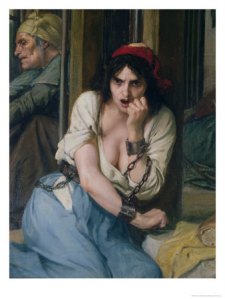
Rose Kennedy, wife of newly-appointed American ambassador to Great Britain, Joseph Kennedy, is shown at center with two of her daughters, Kathleen "Kick" Kennedy (l) and Rosemary Kennedy, at their 1938 presentation at Buckingham Palace. Kathleen's lively personality made her a great hit among the British social set. In 1944, Kathleen made what many considered a brilliant marriage to William "Billy" Harrington, the Marquess of Hartington, the heir to the 10th Duke of Devonshire. Kathleen became the Marchioness of Harrington. Her mother, however, was incensed that Kathleen would marry an Anglican and refused to attend the wedding ceremony. Only Kathleen's eldest brother, Joe Kennedy, Jr., attended. Then, four months later, Billy was killed in the war and Kathleen became a widow. It wasn't long before Kathleen was back in the social whirl of London parties and country estate weekends, and with a new man - a married man. He was Peter Wentworth-Fitzwilliam, 8th Earl Fitzwilliam. Kathleen fell madly for him and publicly became his mistress. Rose was furious - but not why you think. She was incensed because Peter - like Kathleen's first husband, Billy - was an Anglican and not a Catholic. Nevertheless, over her mother's objections, Kathleen planned to wed Peter after his divorce, Catholic or not. Their wedding never came about. In a 1948 trip to the south of France, both Peter and Kathleen died in an airplane crash. Still furious with Kathleen, Rose Kennedy did not attend her daughter's funeral and discouraged Kathleen's eight surviving siblings from attending. Only Kathleen's father, Joseph P. Kennedy, attended her funeral service. Kathleen Kennedy Cavendish was buried in the Cavendish family plot in Devonshire, England. There her body remains today.
Factbox: Kennedy Political Dynasty Marked By Tragedy
(Compiled from Web sites by the World Desk Americas)
The lives of Kennedy family members, noted for their extraordinary accomplishments, have also been marked by tragedy, including the assassinations of President John Kennedy and of Senator Robert Kennedy.
Following is a chronology of some of the tragedies that befell the storied U.S. political dynasty:
1941: Rosemary Kennedy, (pictured here), the oldest daughter of Joseph and Rose Kennedy, who was mentally disabled, was institutionalized for the rest of her life after a lobotomy reduced her abilities. She died in 2005.

Joseph P. Kennedy, Sr. (c) with 2 of his 4 sons: Joe Kennedy, Jr. (l) and John F. Kennedy
1944: Joseph Kennedy Jr., the oldest of the nine Kennedy children, died at age 29 in a plane crash over the English Channel during World War Two while flying a mission.
1948: Kathleen Kennedy Cavendish, the fourth of the Kennedy children, was killed in a plane crash in France at age 28.
1963: President John Kennedy was assassinated on November 22 while riding in a presidential motorcade with his wife in Dallas, Texas, at age 46.
1964: Senator Edward Kennedy, the youngest in the family, narrowly escaped death in a plane crash that killed an aide.
1968: Senator Robert Kennedy was assassinated on June 5 in Los Angeles at age 42, just after he won California’s Democratic presidential primary election.
1969: Edward Kennedy drove off a bridge on his way home from a party on Chappaquiddick Island in Massachusetts. An aide in the car with him, Mary Jo Kopechne, died in the accident.
1984: David Kennedy, a son of Robert, died of a drug overdose at age 28.
1997: Another of Robert Kennedy’s sons, Michael, died in a skiing accident in Aspen, Colorado, at age 39.
1999: John Kennedy Jr. along with his wife and sister-in-law were killed when the plane he was flying crashed in the waters off Martha’s Vineyard in Massachusetts.
For more on the Kennedys, scroll down the right sidebar in “Categories – People – the Kennedys.”



























